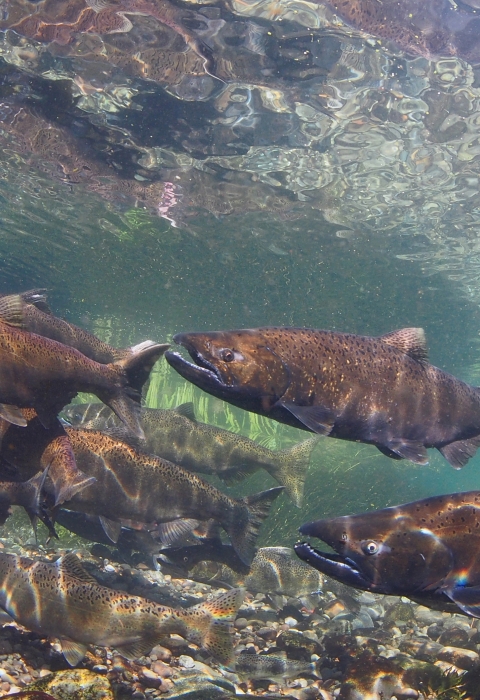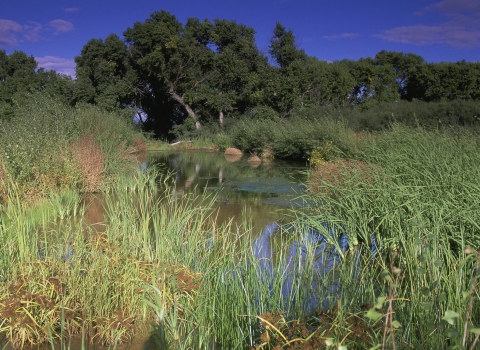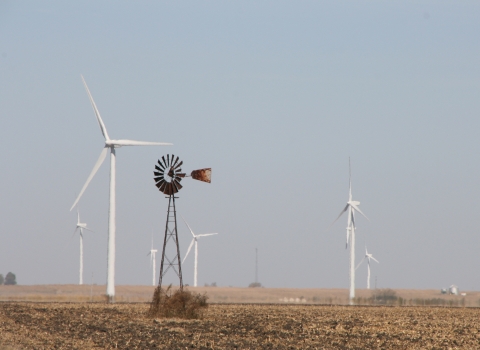SPRINGVILLE, Ala. — The Department of the Interior today announced more than $70 million from President Biden’s Investing in America agenda for 43 projects in 29 states that will improve fish passage fish passage
Fish passage is the ability of fish or other aquatic species to move freely throughout their life to find food, reproduce, and complete their natural migration cycles. Millions of barriers to fish passage across the country are fragmenting habitat and leading to species declines. The U.S. Fish and Wildlife Service's National Fish Passage Program is working to reconnect watersheds to benefit both wildlife and people.
Learn more about fish passage around outdated or obsolete dams, culverts, levees and other barriers fragmenting the nation’s rivers and streams. Projects receiving funding showcase a diverse portfolio of aquatic conservation opportunities and are transformational in improving climate resilience, increasing recreational opportunities, and strengthening local economies.
“President Biden’s Investing in America agenda delivers a once-in-a-generation investment to restore our nation’s rivers and streams, safeguard endangered fish species, protect Indigenous subsistence practices and provide communities with increased opportunities for outdoor recreation and economic growth,” said Secretary Deb Haaland. “When we remove outdated and obsolete barriers to fish migration, we revitalize the entire ecosystem these rivers support and invest in the surrounding community.”
This investment builds on the U.S. Fish and Wildlife Service’s 2022 and 2023 Bipartisan Infrastructure Law Bipartisan Infrastructure Law
The Bipartisan Infrastructure Law (BIL) is a once-in-a-generation investment in the nation’s infrastructure and economic competitiveness. We were directly appropriated $455 million over five years in BIL funds for programs related to the President’s America the Beautiful initiative.
Learn more about Bipartisan Infrastructure Law National Fish Passage Program investments of nearly $73 million in funding for 79 projects spanning the U.S. Across the country, millions of barriers are fragmenting rivers, blocking fish migration, and putting communities at higher risk for flooding. Improving fish passage and reconnecting aquatic systems is one of the most effective ways to help conserve vulnerable species, while building safer infrastructure for communities and improving climate resilience.
The Bipartisan Infrastructure Law delivers a five-year $200 million commitment for the Service to restore free-flowing waters, allowing for fish migration and protecting communities from flooding. The funding is also part of an over $3 billion investment across agencies in fish passage and aquatic connectivity projects under President Biden’s Investing in America agenda.
“This year’s $70 million investment from the President’s Investing in America agenda will have tremendous impacts, not only in restoring fragmented aquatic habitats but in revitalizing communities across the nation,” said U.S. Fish and Wildlife Service Director Martha Williams. “For every $1 million invested in 2022 and 2023 through the Bipartisan Infrastructure Law and partner funding for fish passage projects, an average of 13 jobs were supported and $1.5 million was contributed to the project area’s local economy through construction and implementation.”
The Service continues to collaborate with the 13 agencies that comprise the Interagency Fish Passage Task Force to deliver transformational impact for aquatic species, their habitats, and surrounding communities. The 43 funded projects announced today were developed with local partners and selected through a collaborative process with an interdisciplinary panel of experts from multiple federal agencies, including the Service, the U.S. Forest Service, National Marine Fisheries Service, and Federal Highway Administration. The projects leverage other investments in ecosystem restoration and aim to advance watershed-scale restoration. Additionally, almost half of these projects will be led by or have substantial involvement with Tribal partners, and many will help with conservation efforts for threatened or endangered species.
Projects will be funded in the following states: Alabama, Alaska, Arizona, Arkansas, California, Colorado, Connecticut, Georgia, Idaho, Illinois, Indiana, Maine, Massachusetts, Michigan, Minnesota, Missouri, Montana, New Mexico, New York, North Carolina, Ohio, Oregon, Pennsylvania, South Dakota, Texas, Vermont, Virginia, Washington and West Virginia. Additional project details are available on the Service’s website.
This investment delivers on one of the America the Beautiful initiative’s six early focus areas — supporting collaborative conservation of fish and wildlife habitat and corridors — and is consistent with the Administration’s Corridors and Connectivity Guidance.
The Service’s National Fish Passage Program is a leader in pulling partners together to restore connectivity to these fragmented rivers, floodplains and tidal systems. The program provides financial, engineering and planning assistance to communities, Tribes, states, and landowners to support barrier removal and river restoration and reconnection projects.
-FWS-
The U.S. Fish and Wildlife Service works with others to conserve, protect and enhance fish, wildlife, plants and their habitats for the continuing benefit of the American people. For more information, visit www.fws.gov and connect with us on social media: Facebook, Instagram, X (formerly known as Twitter), LinkedIn, Flickr and YouTube.


